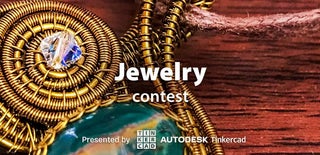Introduction: LED Pendant
I'd like to show you this pendant that I designed with Tinkercad.
A few years ago, I tried Tinkercad, but I believed I could only use simple shapes at the time. I recently experimented and found that importing SVG files allows us to handle free-form shapes.
Supplies
3D print parts
- LED pendant.stl
- LED Pendant cap.stl
Electronics
- 5mm LED (around 3.2V)
The value of voltage to be added for optimal lighting of LEDs is roughly determined by the emission color as follows.
- Red, orange, yellow, yellow-green, and pure green LEDs: roughly 1.8V to 2.2V
- White, light bulb color, blue, blue-green: 3.2V around
- CR2032 Lithium Button Battery
Decorative Items
- UV-LED Liquid Craft Resin
- UV Light
- some decorative parts
- Masking tape
Step 1: Design With Tinkercad
I used Inkscape to convert the drop images to SVG files. I made a folder to hold the batteries and drilled holes for the LED after importing the generated SVG file into Tinkercad.
Note: Tinkercad has an extruded shape generator tool that makes it easy to create free-form shapes. I was just made aware of this feature recently. Since Tinkercad appears to be capable of a lot more, I am looking forward to using it.
LED Pendant
Attachments
Step 2: Printing With a 3D Printer
The following file can be printed with a 3D printer.
- LED pendant.stl
- LED Pendant cap.stl
It is recommended that the layer height be limited to 0.2 mm due to the small size of the print. Adjust the slicer parameter "Horizontal Expansion" to 0.05mm to 0.1mm if the LED or the cap do not fit into the hole.
Step 3: Install LED
- Insert the LED deep into the 3D printed part's hole. The short leg should be at the bottom.
- Cut the two legs of the LED in half lengthwise.
- Bend the upper leg along the circle.
- Insert the CR2032 Lithium Button Battery and confirm that the LED lights up.
Step 4: Fill With Resin
Harden resin around the LED.
- Mask one side of the 3D printed part with the masking tape.
- Put resin a few millimeters thick and cure it with ultraviolet light.
- Add glittering lame and resin, then cure with ultraviolet light.
- Remove the masking tape and cure the opposite side.
Step 5: Arrangement
Rhinestones and stickers can be used to decorate the pendants. It would be interesting to experiment with different colors for 3D printer filaments, LEDs, and resins. I also created an oval pendant. Although it requires more resin, the glowing area is larger than that of the drop shape.
The battery cap goes in when pushed in horizontally. To remove it, put a stick in the hole on the bottom.

Runner Up in the
Jewelry Contest















